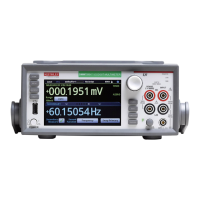8: TSP command reference Model DMM7510 7½ Digit Graphical Sampling Multimeter Reference
8-34 DMM7510-901-01 Rev. B / May 2015
bufferVar.relativetimestamps
This attribute contains the timestamps, in seconds, when each reading occurred, relative to the timestamp of the
first entry in the reading buffer.
Type TSP-Link accessible Affected by Where saved Default value
Attribute (R) Yes
Instrument reset
Not applicable Not applicable
Usage
timestamp = bufferVar.relativetimestamps[N]
The timestamp, in seconds
The name of the reading buffer, which may be a default buffer (defbuffer1 or
defbuffer2
) or a user-defined buffer
The reading number N; can be any value from 1 to the number of readings in
the buffer; use the bufferVar.n command to determine the number of
Details
This read-only attribute is an array (a Lua table) of timestamps, in seconds, of when each reading
occurred relative to the timestamp of the first entry in the reading buffer. These timestamps are equal
to the time that has lapsed for each reading since the first reading was stored in the buffer. Therefore,
the relative timestamp for the first entry number in the reading buffer equals 0.
Example
testData = buffer.make(50)
trigger.model.load("SimpleLoop", 3, 0, testData)
trigger.model.initiate()
waitcomplete()
print(testData.relativetimestamps[1])
printbuffer(1, 3, testData.relativetimestamps)
Create a reading buffer named
testData, configure the instrument to
make three measurements, and store
the readings in the buffer.
Print the relative timestamp for the first
reading in the buffer.
Example output:
0
Print the relative timestamp for the
reading 1 through 3 in the buffer.
Example output:
Also see
buffer.delete() (on page 8-16)
buffer.make() (on page 8-18)
bufferVar.clear() (on page 8-24)
print() (on page 8-231)
printbuffer() (on page 8-232)
Reading buffers (on page 3-13)
Remote buffer operation (on page 3-30)

